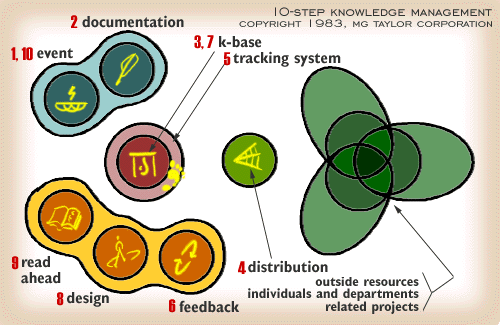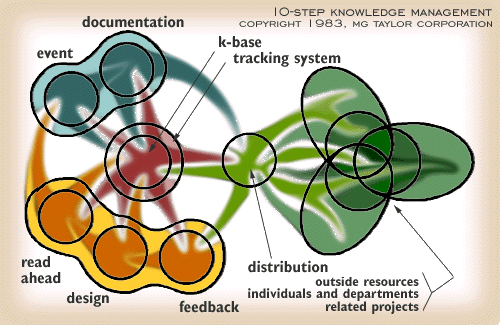
|
|
This document is a supplement to the handbook A Strategic Modeling Language for the 21st Century, published by MG Taylor Corporation and available to network members. In this version there are a few twists to the way the model is organized and used. First a look at the model and the ten steps
If you're familiar with the traditional rendering of the model, you'll notice several differences. First, the model is turned on its side. Second, the outside resources, individuals and departments, and related projects are now represented by the Business of Enterprise model instead of three individual circles. Portions of the model are grouped together into chunks. The connecting lines have been removed for clarity. They'll be put back in later on in this page. And the K-Base has been embedded in the tracking system instead of them being two individual circles. The Business of Enterprise model as shown is not quite accurate. It would be more accurate to show the entire 10-Step Process taking place within the Enterprise and the information from the K-Base being distributed throughout the Web from the inside. Imagine a huge Business of Enterprise web and within it hundreds of little 10-step models in action, their K-Bases all sending and receiving information from each other and from sensors external to the Web as well. Here's an explanation of how the model works.
But we can think about the flow of information in the Web (Enterprise) and through the model from a different vantage point.
Now here's a slightly different look at the model in flow
Note that the K-Base is embedded within the tracking system ring. This means that any message-bearing signal that enters or leaves the K-Base domain is logged--not just those from the distribution stage. Information within events, documentations, feedback, designs, and read aheads all pass through the tracking system into the K-Base, out through the tracking system again and through distribution out to the Enterprise. Note that some information is also passed directly from one step to another without passing through the K-Base. In fact, the vast majority of information in practice is either passed directly from one step to another or lost from the system altogether. Enterprises and other living systems survive by managing a small amount of the data that arrives at their senses, converting it into information and applying it experientially as knowledge. A little Pattern Language philosophy. Think about the model being used not by a group or team, but by a single individual. And imagine this individual has no artifact or tool for recording incoming and outgoing information: information must be passed by word of mouth. In this case, the individual's brain is the K-base and the tracking system. Distribution happens by story-telling. Feedback is a direct communication process, design is creativity, the read-ahead is verbal or perhaps environmental preparation for the next event. Documentation and the K-Base are inseparable. We must remember that although we will build and use silicon-based (or index card-based) K-Bases, every individual who participates in an event carries their own K-Base with them. In collaborative group process, individual brains and silicon-based information management systems are both Knodes in the Web. Imagine that in a DesignShop® event there is not just one 10-Step Model being processed by the Crew to complete the Journal, but many 10-Step Models being processed, and one K-Base per participant and Crew member, in addition to the silicon-based ones. When we design an event for a group, the 10-Step Process will be used many, many times at different time scales. From quick snatches of conversation in passing to the documenting of the entire DesignShop event in a 500 page Journal. We want the design of the event to facilitate as many of those events between Knodes as possible, to encourage and preserve the integrity of the knowledge management process, and to stimulate it to deliver high-edge content as well. Copyright © 1996, MG Taylor Corporation.
All rights reserved 19961101225517.web.bsc |
|
Copyright,
|
iteration
3.5
|





















